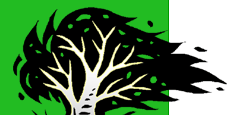| < back
to the hyperbolic tree
Graphical trees provide an intuitive way to display hierarchically
organized information like biological classifications and phylogenies.
Unfortunately, however, as static trees incorporate increased information,
they become cumbersome and confusing. Hyperbolic trees, which are
a dynamic representation of hierarchical structure, are an effective
way to display complex trees clearly.
Deep Green will develop two different trees initially. One is
aimed at students and teachers, and will include only a limited
number of major branches but a lot of pictures, text, and links
to other sources of data. The other is aimed at professional researchers,
and will be as detailed a tree as can be achieved with current,
up-to-date knowledge, and thus will contain thousands of branches.
The latter will have no pictures (as that would make the huge tree
hard to download), but there will be an intermediate webpage clickable
from each node, giving its justification including synapomorphies,
links to the actual data sets and literature in TreeBase, and biological
information to facilitate macroevolutionary studies (such as estimated
age of clade, amount of included diversity, etc.).
The maps at present are intended to be demonstrations of the technique,
not finished products. They were constructed by Ray Cranfill and
Dick Moe using data from Mishler et al. (Ann. Missouri Bot. Gard.
81. 1994), Soltis et al. (Nature 402. 1999) and R. Cranfill (unpublished).
The trees were made using Site Lens Studio, which was donated by
Ramana Rao and Inxight Software Inc., in a collaboration fostered
by a TED (Technology, Entertainment,
and Design) conference in 2000.
Only browsers capable of using Java applets will be able to view
the trees. This means Netscape 4.05 or higher, and Internet Explorer
4.5 or higher, with Java enabled. The files may be slow to load
and start up, especially the first time they are invoked.
The display can be moved around the screen by clicking or clicking
and dragging on the nodes. The display can be modified by using
the panel at the lower left of the screen. Searches can be run by
typing target words in a box in the panel. The portion of the tree
pertinent to the search will be highlighted in red.
|





